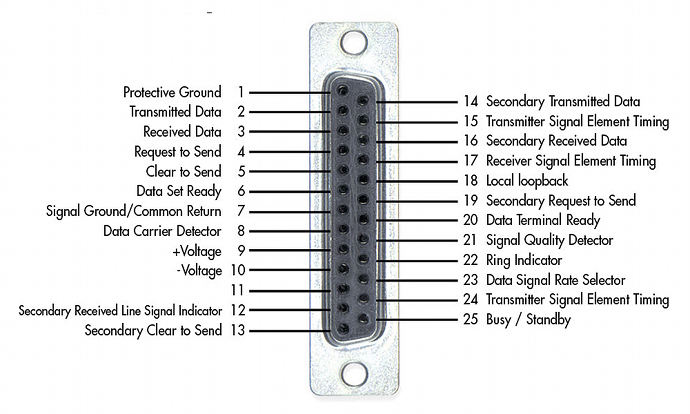RS-232 (Recommended Standard 232) provides serial communication between Data Terminal Equipment (DTE) and Data Circuit-terminating Equipment (DCE). Initially defined in 1962, this standard has been widely used for data transfer between computers, modems, and various communication devices.
Technical Specifications of the RS-232 Standard
RS-232 defines electrical and mechanical requirements for serial data transmission. It is a single-ended interface designed for short-distance, low-speed communication.
Electrical Characteristics: RS-232 uses bipolar signaling. A logical 1 state is defined between -3V and -15V, while a logical 0 state is defined between +3V and +15V.
Connection Ports: The standard typically utilizes 25-pin or 9-pin D-sub (DB-25 and DB-9) connectors. Connector and Pin Usage: In commonly used DB-9 and DB-25 connectors for RS-232 connections, specific pins are designated for particular functions.
DB-9 Connector:

DB9 Connector
DB-25 Connector:

DB25 Connector
Transmission Modes: RS-232 is generally used for asynchronous communication.
Connection Types: A direct connection is established between a DTE (computer) and a DCE (modem), while modem cables are required for communication between two DTE devices.
Data Rate and Distance: RS-232 provides reliable communication at a maximum speed of 20 Kbps and a distance of approximately 15 meters. However, cable length can be increased at lower speeds.
Advantages and Limitations
One of the biggest advantages of RS-232 is its simplicity and broad compatibility. However, the following limitations should be considered:
Susceptibility to Noise: RS-232 is sensitive to electromagnetic interference due to its single-ended nature. Low Data Rate: It is insufficient to meet today’s high-speed data transfer needs.
Short Distance: Signal degradation and data loss may occur as cable length increases.
Limited Multi-Device Support: RS-232 is designed for point-to-point communication and does not support multiple device connections.
Obsolete Technology: Compared to more modern communication protocols (USB, Ethernet, etc.), RS-232 is an outdated system.
Modern Usage Areas and Alternatives
With advancing technology, standards like USB, RS-485, and Ethernet, which offer higher speeds and reliability, have begun to replace RS-232. However, RS-232 is still widely used in the following areas:
Industrial Automation: RS-232 is used for communication with PLCs and other control systems.
Medical Devices: Many older medical devices still utilize RS-232 ports.
Test and Measurement Systems: RS-232 communication is preferred in laboratory devices such as oscilloscopes and multimeters.
Aerospace and Defense: Some systems continue to use RS-232.
Automation Systems: It is used in factory automation and production lines for low-cost and reliable data transfer.
Embedded Systems: RS-232 is commonly used for serial communication in microcontrollers and embedded systems.
RS-232 has been a low-cost and reliable communication protocol in the industry for many years. Although it struggles to meet modern data transmission requirements, it is still preferred in certain applications. RS-232 support continues in industrial and scientific equipment to ensure backward compatibility with older systems. However, in systems requiring high-speed and long-distance communication, more advanced alternatives are preferred. While RS-232 is expected to remain in use in some industrial applications, its overall usage area is gradually shrinking. more advanced alternatives are preferred

